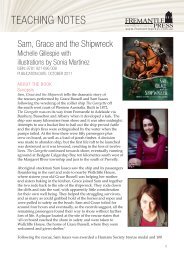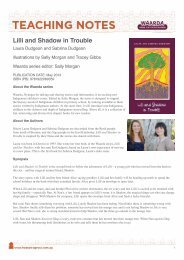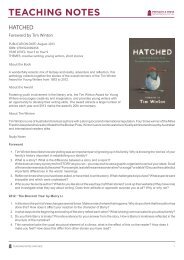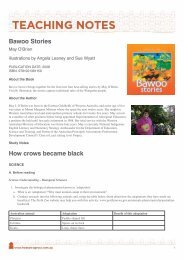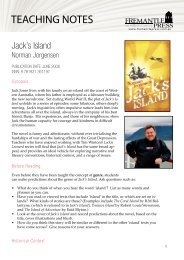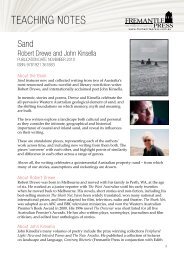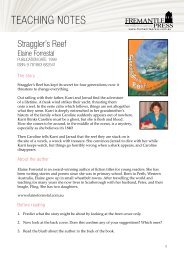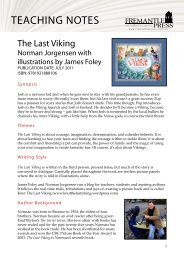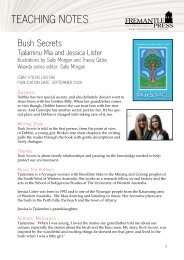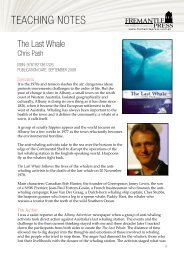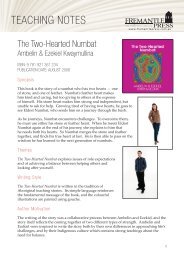IN ECSTASY TEACHING NOTES WEB.pdf - Fremantle Press
IN ECSTASY TEACHING NOTES WEB.pdf - Fremantle Press
IN ECSTASY TEACHING NOTES WEB.pdf - Fremantle Press
Create successful ePaper yourself
Turn your PDF publications into a flip-book with our unique Google optimized e-Paper software.
TEACH<strong>IN</strong>G <strong>NOTES</strong><br />
fine independent publishing<br />
www.fremantlepress.com.au<br />
In Ecstasy<br />
Kate McCaffrey<br />
ISBN: 9 781921 361166<br />
PUBLICATION DATE: APRIL 2008<br />
Inspiration<br />
Drugs have always been of interest to teens, and books about<br />
drugs have been read in schools for decades. Go Ask Alice,<br />
published in 1971, was used extensively to deliver an antidrug<br />
message to the classroom. Purporting to be non-fiction,<br />
it tells the story of a young girl’s descent into the 1970s<br />
drug world. It was replaced in schools with Anna’s Story,<br />
published in 1996 — the tragic tale of Anna Wood, who died<br />
after taking one ecstasy pill. The message in both these books<br />
is clear — if you take drugs you die.<br />
But teenagers are an inquisitive and critical audience. They<br />
know when they are being patronised and they can sniff out<br />
falsehoods quickly. Most teenagers know people who have<br />
used, or use drugs, and many take drugs themselves. The<br />
simplistic message of the anti-drug literature — that taking<br />
drugs leads straight to ruination — ignores the fact that most<br />
drug users take drugs that make them feel good, and most survive the experience. What,<br />
crucially, young users may not do though, is give any thought to the long-term effects of<br />
drug use, or to the possibilities of what might go wrong.<br />
Little literature is available that accurately reflects both the appeal and the consequences<br />
of drug use from a teenage perspective. I wanted to write a book that kids would want to<br />
read, and give a realistic account of the attractive world drugs initially presents — and the<br />
ugly world of abuse that sits so close beside it. And I wanted to explore the question of<br />
why kids take drugs. And what compels them to do it again and again.<br />
In Ecstasy is a hard-hitting portrayal of teenage drug use, describing the slide from<br />
recreational use to abuse. It examines contemporary pressures on adolescents; explores the<br />
dynamics of a close teenage friendship and its unravelling; and emphasises the need for<br />
love, trust, attention and understanding.<br />
1
TEACH<strong>IN</strong>G <strong>NOTES</strong><br />
fine independent publishing<br />
www.fremantlepress.com.au<br />
Plot<br />
brief<br />
Sophie and Mia have been friends for ever, but that’s all about to change. When the<br />
girls take ecstasy at a party, just for fun, they start down a road they’ll have trouble<br />
leaving. Sophie has an early, bad experience and swears off drugs completely, but Mia is<br />
captivated. She is soon embroiled in a serious relationship with ‘hot’ Lewis, who shows<br />
her a life she’s only ever imagined. With the excitement of Lewis and his cool set of friends,<br />
Mia fails to provide the friendship and support Sophie needs in her time of crisis. And, in<br />
the face of Sophie’s disapproval of the drug-scene, Mia pulls even further away.<br />
Reality breaks into Mia’s dream world with the overdose and death of Tower, one of<br />
Lewis’ oldest friends. She discovers Lewis is not the person she believed him to be at all.<br />
Retreating to the sanctuary of home, Mia finds she may have burned her bridges.<br />
Alone and depressed, she is inexorably drawn back to the comfort of drugs. This time,<br />
unprotected by Lewis, she descends into a much darker and heavier pattern of abuse.<br />
Finally, at her lowest point, she suffers a psychotic episode and realises she must get<br />
out or be lost forever. Mia’s recovery is slow and painful. Her friendship with Sophie<br />
slowly rebuilds and her future looks brighter, but it is clear that the drugs have left her<br />
permanently changed — physically, mentally and emotionally.<br />
expanded<br />
Central to the plot is the relationship between Mia and Sophie. Chapter 1 depicts the two<br />
girls as ‘normal’ teenagers and establishes differences between them which may underpin<br />
the way people handle drug-taking differently, dependent on their psychological makeup.<br />
Sophie sees Mia as gregarious and entertaining. Mia feels like the poor cousin in the<br />
friendship, overwhelmed by Sophie’s beauty.<br />
As the story progresses we watch Mia slip further away from Sophie. The bond of their<br />
friendship is stretched to the point where at Tower’s overdose it snaps completely. Sophie,<br />
who once said confidently, ‘We’ll be friends forever,’ can only watch in horror as Mia is<br />
transformed into a person she doesn’t know at all.<br />
Prior to Tower’s overdose the reader is aware, even if all the central characters are not, that<br />
the friendship is disintegrating. Sophie says (p. 134), ‘So we were engaged in this farce.<br />
Still pretending we were best friends … I’d walk away with relief … waiting for him to<br />
drive her home.’<br />
While many readers empathise with Mia, they can also see in the early stages that Sophie’s<br />
awareness, not clouded by drugs, is more reliable. Thus the reader is ahead of Mia’s<br />
2
TEACH<strong>IN</strong>G <strong>NOTES</strong><br />
fine independent publishing<br />
www.fremantlepress.com.au<br />
painful realisation after Tower’s death: ‘I felt deluded and deceived … I cried over Lewis,<br />
because he wasn’t the person I thought he was …’ (p. 161).<br />
She stops taking ecstasy for a while. But addiction is stronger than that, and after Sophie<br />
rebuffs her friendship in an instance of tragically bad timing, Mia talks herself back into<br />
the drug world. ‘It was a wonderful experience … Why had I stopped? I’d fallen for the<br />
hype and scare tactics.’ (p. 175).<br />
Sophie recognises the importance of their friendship too late. Mia has already hooked up<br />
with Glenn and a very different drug world to the essentially middle class one that Lewis<br />
introduced her to. This one is full of addicts and dealers, seedy apartments and debauched<br />
sex.<br />
Oblivious to all but the world of ecstasy, Mia has eyes wide shut to the degradation. It is<br />
only after a psychotic episode that she sees where she is and desperately tries to find her<br />
way back.<br />
Narrative Structure<br />
The story is told through alternating chapters by the two girls. Mia’s is told in the present<br />
tense, as it occur to her in the moment, and without any perspective. Sophie’s takes us into<br />
the back story and is told in the past tense, with the benefit of insight and hindsight.<br />
Sophie is thus able to judge and comment on what Mia is describing, and evaluate her<br />
own role in the events. In this way Sophie can act as a moral arbiter, in a voice teenagers<br />
can to relate to, since it has none of the patronising tone that might be suspect in a teacher<br />
or parent trying to convey the same information.<br />
The time difference also allows for parallels between the two girls’ story telling. Thus<br />
Mia’s comment on having sex so easily with Lewis, ‘I was starting to feel a bit stupid’ (p.<br />
80), parallels Sophie’s admission, ‘I felt so stupid’ (p. 66), regarding splitting up with Dom<br />
because of her lie.<br />
Sophie’s lie — which was based on peer pressure and needing to project an image for<br />
acceptance — drives the first part of her narrative. Mia essentially falls in the same trap —<br />
ecstasy gives her a confidence that Sophie, a victim in her own right, cannot see.<br />
The alternating perspectives also allow for parallels between the two girls’ differing drug<br />
experiences. After Sophie’s night of terror, Mia’s next chapter begins ‘I woke up feeling like<br />
it was Christmas.’ Sophie is dealing with an unimaginable reality and Mia in her ecstasy<br />
is enveloped by her chance to be the girl she’s always admired and is oblivious to her best<br />
friend’s plight.<br />
3
TEACH<strong>IN</strong>G <strong>NOTES</strong><br />
fine independent publishing<br />
www.fremantlepress.com.au<br />
Lewis’s party draws them together. Both crave to have the friendship back, but realise<br />
things have changed, and neither will admit it. Their estrangement reduces Sophie’s voice<br />
in later chapters, and the new world Mia occupies now arouses her mother’s attention —<br />
and ultimately sends her running to her father’s, where she has carte blanche to do as she<br />
pleases.<br />
Once Mia enters rehab, Sophie is able to re-enter her life and offer the friendship and<br />
support needed. This concluding chapter offers hope. The friendship is rekindled, the<br />
promise, though shrouded in uncertainty, is there.<br />
Characters<br />
THE GIRLS<br />
Outwardly confident and beautiful, Sophie hides her own insecurities, which, hidden,<br />
exert a force over the events of the novel. Even so, Sophie is the voice of reason, of<br />
hindsight and often judgement. She extracts herself from danger and tries to take Mia with<br />
her. ‘It’s called self preservation — I learnt about it in biology’ (p. 167).<br />
Mia, the self-deprecating introvert, discovers the version of herself that Sophie sees —<br />
funny, gregarious — only through the drugs. And that is hard for her to let go of; she<br />
thinks she can’t achieve it without ecstasy. Ultimately, this desire to be the ‘other’ Mia is<br />
what drives her back into the drug world, despite Tower’s death.<br />
Why do the two girls handle things so differently? Focus on family, self esteem, the desire<br />
to belong.<br />
THE MOTHERS<br />
We see Mia’s mother from Mia’s perspective. Initially she is sympathetic and sees her<br />
mother as abandoned and fragile, but ultimately she feels abandoned as her mother and<br />
Sophie move on without her, and we see her view switch to one of sheer hatred (p. 192).<br />
‘She was such a small person, scurrying around wiping bench tops …’<br />
But it is her mother she calls when she escapes from Glenn’s (p. 221). ‘I watched mum<br />
get out of the car, her dressing gown flapping behind her like a cape …’ Her mother, her<br />
rescuer, never judges her as she takes her home, cleans her up and gets her to a doctor. Mia<br />
ultimately realises the depth of her mother’s unconditional love (p. 241), and how warped<br />
her own perspective was when she was on drugs (p. 256). ‘The house seemed so big and<br />
welcoming … I had run from this haven to the squalor of Glenn’s flat.’<br />
4
TEACH<strong>IN</strong>G <strong>NOTES</strong><br />
fine independent publishing<br />
www.fremantlepress.com.au<br />
Mia views Sophie’s mother (p. 30) as ‘a mega control freak … we both hate her.’ But<br />
Sophie’s self esteem is largely based on her mother’s love and admiration for her.<br />
She admires her mother and wants to please and keep her approval (p. 46). ‘When I think<br />
about all the times I’ve heard my mum talk about me to her friends — about how I know<br />
myself, about how strong and smart I am — if she knew, she’d never look at me in the<br />
same way again and that’s more than I could handle.’ And later (p. 54), ‘I became the<br />
confident person my mum always thought I was.’<br />
THE BOYS<br />
Lewis and Glenn demonstrate some of the ways in which young girls can be easily<br />
manipulated by boys. Lewis hides behind his upper-middle class background, but is no<br />
different from Glenn. Mia eventually realises this, as she says in defence of Glenn (p. 188),<br />
‘he wasn’t so different from Lewis. In fact really he was more honest because he didn’t<br />
hide behind some bullshit image.’<br />
Dom demonstrates to Sophie that there are guys who won’t manipulate girls for their own<br />
ends. He represents up-front honesty and a balanced power relationship based on liking<br />
and mutual respect.<br />
Discussion topics<br />
Perception<br />
Mia and Sophie think of each other as best friends, but how well do they really know one<br />
another? Each sees the other as a particular kind of person, but their self-perception is<br />
quite different.<br />
• Does Mia and Sophie’s relationship reflect a normal disjunct or is it fatally flawed?<br />
• If Sophie and Mia had been more honest with each other how might things have happened<br />
differently?<br />
• Do you feel your friends/family/teachers really know you?<br />
• Is the ‘you’ you show to the world the same as your ‘inner you’?<br />
drugs in society<br />
There are many kinds of drugs in common use throughout society, from coffee and<br />
cigarettes to heroin and crystal meth.<br />
• Why are some drugs acceptable and others not?<br />
• Who decides which drugs should be legal and which drugs illegal, and how?<br />
• How have attitudes towards different drugs changed over time?<br />
• Which drugs cause the most problems in society? How can their effects be gauged?<br />
5
TEACH<strong>IN</strong>G <strong>NOTES</strong><br />
fine independent publishing<br />
www.fremantlepress.com.au<br />
ecstasy<br />
Ecstasy is a manufactured drug. It is relatively new to the market though it has been in<br />
existence for nearly a century.<br />
• How much do you know about ecstasy, its use and its history?<br />
• What is in ecstasy and how is it made?<br />
• How does ecstasy produce its effect?<br />
• What are the physiological impacts of ecstasy?<br />
• How does ecstasy differ from other drugs?<br />
Drug abuse<br />
Many people take drugs but only some become addicted.<br />
• Is all drug use drug abuse?<br />
• What is it that makes some people more susceptible to drug use than others?<br />
• What methods of rehabilitation are currently used? How effective are they?<br />
• What is an overdose?<br />
• What should you do if someone is overdosing?<br />
Anti-drug Campaigns<br />
Governments have long worked to counteract drug use with varying degrees of success,<br />
from legislating against use (eg. ecstasy) to advertising against use (eg. tobacco).<br />
• How effective do you think current anti-drug work is?<br />
• How could governments more effectively target you?<br />
Other resources<br />
• Australian Drug Foundation, www.adf.org.au<br />
• www.reachout.com.au<br />
• www.kidshelp.com.au<br />
• www.turningpoint.org.au<br />
• www.druginfo.adf.org.au<br />
• www.beyondblue.org.au<br />
• www.somazone.com.au<br />
• www.addict-help.com<br />
• www.drug-rehab.ca<br />
• www.drugs-info.co.uk<br />
• www.talktofrank.com<br />
Major Task: Essay Writing<br />
Complete the worksheets on characterisation and issues as preparatory work for an essay<br />
on the novel In Ecstasy.<br />
6
TEACH<strong>IN</strong>G <strong>NOTES</strong><br />
fine independent publishing<br />
www.fremantlepress.com.au<br />
Issues<br />
Reading Outcome<br />
The main issues discussed in the novel In Ecstasy include drug use, family relationships,<br />
self-perception and friendship. Explain each issue in your own words and support your<br />
ideas by using examples from the novel. You will need to consider the characters involved,<br />
the conflicts they face and resolutions that emerge. Include textual references where<br />
possible.<br />
drug use<br />
family relationships<br />
self-perception<br />
friendships<br />
7
TEACH<strong>IN</strong>G <strong>NOTES</strong><br />
fine independent publishing<br />
www.fremantlepress.com.au<br />
Character Challenge<br />
Reading Outcome<br />
Choose four characters from the novel, including Mia and Sophie, the main characters. From<br />
the following list match five adjectives that are appropriate to the specific characters. Write<br />
a dictionary definition for the adjective to ensure you understand the meaning of the word.<br />
Provide evidence from the text to support your idea. Write the example in quotation marks<br />
and record the page it appears on. Then explain in your own words how the adjective and<br />
the example are linked. If you wish to use an adjective that is not on the list feel free to do<br />
so, but you may only use each adjective once throughout the exercise.<br />
ADJECTIVES:<br />
• indifferent<br />
• accepting<br />
• inquisitive<br />
• curious<br />
• astounded<br />
• compassionate<br />
• brave<br />
• obnoxious<br />
• insensitive<br />
• brash<br />
• persuasive<br />
• cowardly<br />
• aggressive<br />
• sensitive<br />
• intelligent<br />
• callous<br />
• spoilt<br />
• selfish<br />
• indulgent<br />
• resentful<br />
• jealous<br />
• envious<br />
• repressed<br />
• shy<br />
• generous<br />
• rebellious<br />
• trustworthy<br />
• boastful<br />
• friendly<br />
• humorous<br />
• conniving<br />
• spiteful<br />
• ignorant<br />
• naive<br />
• kind<br />
• dutiful<br />
• helpful<br />
• emotionless<br />
• melancholy<br />
• reserved<br />
• self-conscious<br />
• impatient<br />
• deprived<br />
• exceptional<br />
• reckless<br />
• petty<br />
• calm<br />
• deceitful<br />
• manipulative<br />
• cruel<br />
• gregarious<br />
• impulsive<br />
• confident<br />
• obliging<br />
• lackadaisical<br />
• belligerent<br />
• amicable<br />
• tenacious<br />
• affable<br />
• surly<br />
8
TEACH<strong>IN</strong>G <strong>NOTES</strong><br />
fine independent publishing<br />
www.fremantlepress.com.au<br />
Character Comparison<br />
We learn a lot about the characters Mia and Sophie through what they convey about<br />
themselves in their own chapters. We also learn about them from what the other says.<br />
Their views of other characters are vastly different too. Create a Venn diagram where you<br />
compare and contrast their own self perception against the other’s view of them.<br />
Make sure you make a statement and support it with evidence from the text.<br />
You could also create a Venn diagram showing Mia and Sophie’s differing opinions of the<br />
other characters—Lewis, Glenn, Dom.<br />
Mia vs Sophie<br />
Mia<br />
Sophie<br />
9
TEACH<strong>IN</strong>G <strong>NOTES</strong><br />
fine independent publishing<br />
www.fremantlepress.com.au<br />
Character Challenge<br />
Reading Outcome<br />
Character Name: Mia<br />
Adjective and Definition<br />
• Anxious: worried and<br />
tense because of possible<br />
misfortune.<br />
Textual reference and page<br />
number<br />
• ‘I stood slightly behind<br />
Sophie on the street<br />
verge clutching a pack of<br />
vodka cruisers…’ (p11)<br />
Explanation<br />
• Mia is socially insecure<br />
and relies on Sophie to<br />
‘lead the way.’ She is too<br />
frightened to do things<br />
on her own.<br />
10
TEACH<strong>IN</strong>G <strong>NOTES</strong><br />
fine independent publishing<br />
www.fremantlepress.com.au<br />
Student Brief<br />
TASK 7: Essay writing<br />
OUTL<strong>IN</strong>E: Write an essay examining how the<br />
narrative structure of in ecstasy lends to the<br />
reader’s understanding of character.<br />
HOW LONG WILL YOU NEED ?<br />
WHAT YOU NEED TO DO:<br />
STAGE ONE:<br />
Complete character challenge and form groups to discuss and share ideas about the main<br />
characters in the text.<br />
In groups draw an A3 sized chart showing how attitudes and values are related to the content<br />
of the novel.<br />
STAGE TWO:<br />
Revise essay writing skills and examine the essay question.<br />
Using class notes including comprehension question answers, plan and draft an essay<br />
response to the question.<br />
STAGE THREE:<br />
Peer edit your essay draft<br />
Produce a final copy.<br />
11




